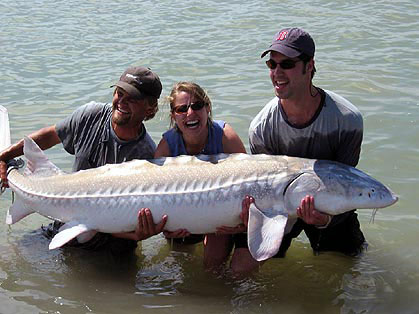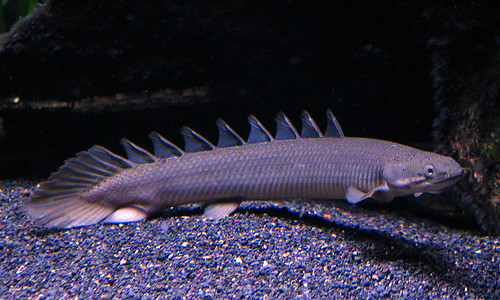
According to records, hagfish have been around for more than 300 million years. Found in waters that are relatively deep, the animal is sometimes called slime eels, but they are not actually eels, and in fact they do not even like fish at all, loh continue what is? according to some scientists. They are a very strange animal in all respects, they have the skull but did not have a spine, and they have two brains. Nearly blind, they eat at night they ate carcasses of large animals (fish, whales, etc.) that falls into the seabed. they have almost no natural enemies.
2.Arowana

Osteoglossids (Arowana), these fish already exist in the Jurassic period. Today, they are found in the Amazon, and in some parts of Africa, Asia and Australia. Sometimes kept as exotic pets. Arowana fish that eat small animals and worms that they could get, including birds and bats which they catch while flying, Arowana can also jump up to 2 meters into the air. In China, the arowana is known as "fish-dragon" because of their appearance, and they are considered a sign of good fortune brought aka hockey.
3.Frilled Shark

This deep-sea predators, one of the most primitive shark alive today, is a relic of the Cretaceous period, frilled sharks can grow up to 2 meters (size larger than the female shark shark men) and they live in deep water, where they eat mostly squid. They are harmless to humans, and as a matter of fact, sharks spend their entire lives without seeing human beings as they live in the deep sea. Only the dead specimens are usually visible on the surface and recorded by fishermen or scientists.
4.Sturgeon Fish

Sturgeon has been known as one of the main sources of caviar (fish eggs) due to overfishing, the population is being threatened at this time. Largest sturgeon species can grow up to 6 meters, equal to the white shark, Sturgeon eat small animals from the seafloor and do not pose danger to humans unless provoked
5. Saw Fish

These animals are the victims of the Cretaceous period, and can be found either at sea or in the river at a depth of 100 km with a length of 7 meters, this fish looks like a shark with a mouth like a chainsaw, but not included in Sawfish species of sharks just like .
Sawfish diliat2 if it's actually not a race but including race sharks stingrays, from under his body shape is flat, unlike the shark underneath a more slender streamlined shape that allows sharks to swim fast in the aer, and Sawfish have a small mouth that is parallel with lower body fused with his body like a manta ray, while the shark? more sharks seem to have a big jaw itself. also can see a flat head Sawfish does not like sharks. Sawfish fins also have a front parallel to the bottom.
yah some adult Sawfish can grow up to 5.8 m. oh yes there are some people who are often mistaken with Sawfish and sawshark., if Sawfish it like that already in jelasin above, while sawshark is like having a big jaw like other sharks , and certainly his body shape is different, more like a shark.
6.Polypterus Senegalus

Fish Africa is often called the "dinosaur eel", because of their appearance and jagged dorsal fins. They're actually not an eel, but family members Bichirs. Although often sold as exotic pets "dinosaur eel", they can survive out of water for long periods during their skin remains moist.
7.Coelacanth

A group of researchers from the University of Sam Ratulangi
Indonesia Institute of Science and Aquamarine Fukushima Japan regained its prehistoric fish called the coelacanth. The fish was estimated to have existed 380 million years ago.
Fish were found in the first day of the investigators on Monday (14 / 9) using the ROV (remotely operated vehicle). The fish was found in the waters of Talise, North Minahasa, in the depths of 155 meters. "This discovery is very surprising. Fish was found alive and swimming freely habitat, "says Prof. Alex Masengi, Dean of the Faculty of Fisheries and Marine Sam Ratulangi University. On 27 June 2007, the same team found a coelacanth fish in the waters Malalayang, the bay of Manado, North Sulawesi at a depth of 190 meters. The second discovery is about 120 kilometers north of the previous one.
Coelacanth fish habitat to be around a depth of 180 meters with a maximum temperature of 18 degrees Celsius in mountain basins of the sea. These fish live only in waters
South Africa and the western waters of eastern Indonesia each
respectively called Latimeria chalumnae and Latimeria menadoensis. New species found in Manado in 1999 shocked the world because since 1940 the coelacanth species known only from the western part of Madagascar. Coelacanth prehistoric fish and categorized as living fossils because it allegedly has existed since the Devonian era, about 380 million years ago.
0 comments:
Post a Comment